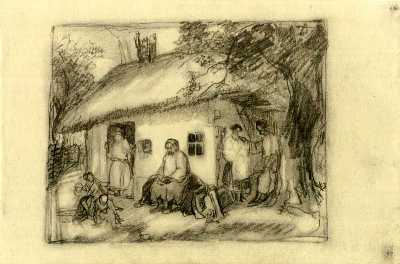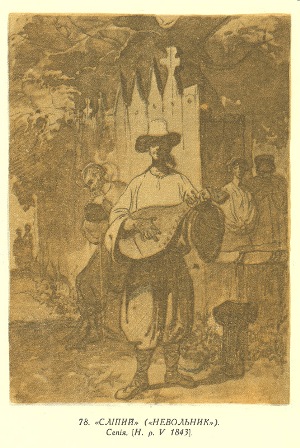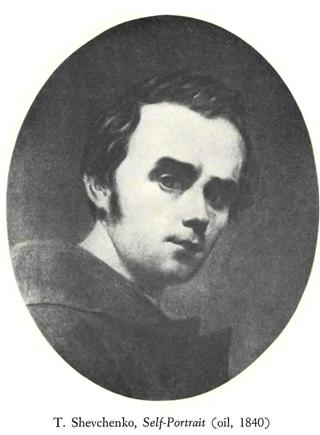TARAS SHEVCHENKO’S LIFE AND WORK
Taras Shevchenko's "The three years" period. S
truggling against political and social injustice (C.H. Andrusyshen)
(Introduction of "The poetical works of Taras Shevchenko. The Kobzar" by Constantine Henry Andrusyshen and Watson Kirkconnell)
Towards the end of 1842, for reasons as yet undiscovered, he undertook a journey to Copenhagen and Stockholm, during which he fell seriously ill. He returned to St. Petersburg with his health undermined. Whatever the other results of this trip, it was productive of one of his masterpieces, “Hamaliya,” in which he quite dramatically Actionized a Cossack attack on Tsarhorod (Constantinople) amid the elemental fury of the Black Sea, such as he himself experienced in his voyage across the Baltic.
After some fourteen years of absence from his native land, Shevchenko finally, in the summer of 1843, visited Ukraine. A reunion with his brothers and sisters was happy, though tempered by the bitter fact that they still remained serfs. Among the numerous friends on whom he called in various localities, he met in Kiev P. Kulish, the famous Ukrainian poet, novelist, and ethnographer, in whose company he investigated several historical Cossack sites and monuments.

Taras Shevchenko, "Peasant family", 1843Later, Shevchenko alone visited the site of the former encampment of the Cossack Sitch on the Dnieper’s island of Khortitsia, and other localities made famous during the period of the Hetmanate. Particularly significant was his sojourn in Yahotin, where his friendship began with Prince Repnin and his daughter Varvara (Barbara), with whom Shevchenko spent much time in pleasant social and literary conversations. His attachment to her developed into a deep affection, and his qorrespondence with her continued throughout his life. For a time there was even a rumour that they seriously considered marriage, the only drawback to wedlock being the disparity in their respective social status.
Wherever Shevchenko went in Ukraine, he found that his fame had preceded him. Everywhere he was lionized by the very cream of Ukrainian society and celebrated by the populace. Although he enjoyed being so treated in the elite circles, the poet none the less keenly felt the utter disregard with which the higher elements of the Ukrainian community treated the peasant masses. True enough, under the influence of Western ideas and ideals of brotherhood, equality, and freedom, his hosts waxed most eloquent in that democratic respect, but their sentiments, however resoundingly expressed, were rarely put into practice. And it was with a bitter feeling towards them that Shevchenko, after some ten months of sojourn in Ukraine, returned to St. Petersburg to complete his studies at the Academy.
But it was in political injustice that he found the root of the social evils in Ukraine. Under that keen impression he wrote such poems as “The Excavated Mound” (Rozrita Mohila) in which he bemoaned the sorry state of Ukraine as symbolized by the mutilated mound in which the Cossack freedom of the land lay buried; and above all he wrote the politically significant poem, “The Dream” (Son), where his soaring soul, as in a dream, surveyed the entire Russian Empire plundered and oppressed by the tyrant tsars and their underlings. There, in no uncertain terms he attacked the tsarist regime for the injustice perpetrated on his people and on other peoples cruelly coerced into the Russian fold. Under his scathing denunciation, first of all, came Peter I who, after the battle of Poltava, put an end to Cossack freedom as symbolized by the death of the acting Hetman Pavlo Polubotok in one of Peter's dungeons. With telling effect did the poet bring out the vision of the tattered Cossack regiments forced to dig canals under intolerable conditions in the frozen Russian north, and to build for the Tsar on swampy terrain, virtually on their very bones, the imperial capital, St. Petersburg. Likewise ruthlessly did Shevchenko castigate Catherine II who in 1775 destroyed the last vestiges of the Zaporozhian Sitch (the Cossack encampment beyond the Dnieper's rapids) and settled the entire Cossack region with German immigrants. It was also under this ruler that serfdom received the official stamp of approval. The hardest struck, however, was Tsar Nicholas I, whom Shevchenko, in two most ludicrous scenes of “The Dream” presented as an uncouth bear and boor surrounded by his plate-lickers upon whom he was dependent for his power and without whose aid (after he did away with them) he appeared a sorry sight indeed. Not even the Empress escaped Shevchenko's searing ridicule, for her he portrayed as a “dried-up mushroom” and as a stork-like creature with a tremulous head. The insult was remembered by both, and when Shevchenko was later condemned to exile for It is to be noted that before his two visits to Ukraine, Shevchenko’s poetry was idealistic in its approach to her historical past, which he romanticized in his ballads and heroic poems as one would some distant glowing myth. After his direct contact with Ukraine, however, when he saw with his own eyes the sorry existence of his people, his idealistic attitude changed, and his Romanticism gave way to a creativity full of political and social significance, as is revealed in such poems as “The Dream," “The Great Mound,” “My Friendly Epistle," and others, in which he mercilessly (often satirically) exposed the wretched present as being the result of the wicked past political reasons it contributed more than anything else to his severe punishment and prompted the Tsar to insist in a personal addition that the poet be strictly forbidden to write and to paint while serving the sentence.
During his peregrinations in Ukraine Shevchenko occasionally sketched the ruins of hetman towns, and from his impression of those sites he conceived the idea of doing a series of paintings under the title of "A Pictorial Ukraine” (Zhivopisnaya Ukrayina) in which he intended to illustrate the entire political history of his land. In this he was encouraged by Princess Repnin, and it was decided that he would do ten illustrations a year. The proceeds from these works were to be used for the emancipation of Shevchenko's entire family from serfdom. The whole of 1844 was spent in planning and beginning this project, which unfortunately, but for a few engravings, did not materialize, although not for lack of subscribers.
It may be of interest to note that shortly before this venture Shevchenko did an illustration to Shakespeare's King Lear, portraying the hoary man in his last days, during the storm, and accompanied by his clown. He engraved this scene and took part in reproducing it by means of galvanography, or galvanoencaustic, then in an experimental stage. The light effects fixed in this work are truly Rembrandtesque.
Having completed his studies at the Academy of Art, Shevchenko in 1845 once more journeyed to Ukraine to further his research in historical and archaeological matters pertaining to his native land. In that connection he worked in conjunction with the Kiev Archaeological Commission, whose purpose was to investigate the ancient monuments of Ukraine which he was to draw or sketch. And again Shevchenko had an opportunity to visit in various parts of the country those historical places which were to inspire him to new heights of pictorial and poetic achievement.
During this second sojourn in Ukraine Shevchenko conceived a desire to marry Teodosia, the daughter of H. Koshetz, the parish priest in his native village of Kirilivka. The matter reached the point where he was emboldened to propose to her; but the father, considering the poet's lowly pas, refusecl his blessing. Teodosia, who loved Shevcenko deeply, could not endure the parental refusal which, it is said, was the cause of her eventual insanity.
The Уеаг 1845 proved the most productive of his literary career. “Under great inspirational tension he wrote such significant poems as «The Heretic,” “The Blind Man” (Nevolnik), and the drama-mystery "The Great Mound” (Velikiy Liokh), all in a matter of two weeks.
Other masterpieces included “The Caucasus,” “The Hired Girl” (Naymichka), “The Psalms of David” (a selection of ten), and a most intensely concentrated poem entitled “To the Dead, to the Living, and to Those Yet Unborn, My Countrymen All Who Live in Ukraine and outside Ukraine, My Friendly Epistle.” In addition, he wrote a goodly number of shorter pieces of great importance; and all these, together with everything he had written since 1843, he gathered into a collection that he entitled “The Three Years” (Tri Lita). Although it was intended for publication, it contained so much matter subversive of the tsarist regime that he could not hope to have it pass the strict censorship. For that reason the collection circulated throughout Ukraine and in parts of Russia in manuscript copies.
All these poems, both short and long, are saturated with the spirit of revolt against the political and social injustice obtaining in Ukraine, and present a succinct record of the wrongs done to the Ukrainian peasantry by the ruling classes. In “The Heretic,” Shevchenko reacted fiercely against the unscrupulousness of those who, in the name of Christianity, sought to destroy the least manifestation of truth and justice if these went against the oppressors autocratic grain. There, too, under the influence of the Slavist revival, Shevchenko expressed himself in favour of a union of all Slavic races into a single fraternal federation (this subject will be expounded further in connection with the aims of the Saints Cyril and Methodius Brotherhood). In “The Hired Girl,” he continued the theme he had already presented in “Katerina,” but with a more fortunate denouement. “The Blind Man” is a love story abounding in Cossack manners and customs, and includes the famous duma in which Shevchenko marvellously captured the measure and the mood of the sixteenth-century specimens of that kind.
The poem which gained him added ire from the authoritarian government was “The Caucasus.” Here he gave full vent to his protest against the Russian conquest of the Caucasian peoples who had been subjected by force of arms to the yoke of tsarist imperialism under the guise of Christian ideals which the Russian rulers proclaimed but never practised even in their own midst, let alone on the territories they high-handedly annexed. The poem reeks with bitter irony and sarcasm at the pharisaical attitude of the conquerors, and so cutting is the indictment that it made the despot Tsar and his satraps squirm with irritation and rage at the audacity of the former serf. Two years later, when Shevchenko appeared before his tribunal, Nicholas was ready for him.
It must be noted that during his first visit to Ukraine Shevchenko was under the impression that the injustice done to his people was to be attributed, in the main, to the repressive tsarist rule which sought at every step to destroy not only all vestiges of Ukrainian freedom but also the sights and signs that reminded the race as a whole of its former liberty. During the second visit, while becoming more fully convinced of the Russian guilt, he began to see more clearly that the Ukrainian landlords and a goodly fraction of the elite were even more to blame for the sorry state in which his country found itself. He arrived at this conclusion by personally observing at social gatherings their indifferent and even negative attitude towards the common folk. In spite of their verbosity in extolling the virtues of democracy, of which they had heard perforce during their frequent visits to Western Europe, they continued to neglect the spiritual and material well-being of their less fortunate fellow-men, most of whom were entrusted to their care; and while the serfs vegetated in destitution and ignorance, the masters, waxing ever prosperous on their underlings’ labour, vied with each other in seeking to gain decorations, honours, and official ranks from the tsarist government. For that reason, Shevchenko vented his ire against them in his symbolic mystery-poem “The Great Mound,” where, in presenting three voracious ravens, Ukrainian, Polish, and Russian, he considered the first as the greatest enemy of the Ukrainian people; and so keenly did he feel the decrepit condition of his people that he deemed even involuntary sins, committed to the detriment of the nation by three innocent female beings, as mortally grave, for they none the less contributed to the calamity of Ukraine. As harsh as was Shevchenko’s accusation of the Ukrainian intellectuals in “The Great Mound,” that voiced in “My Friendly Epistle” was even more severe. There, with the wrath of a Hebrew prophet and with bitter irony, he exposed the vices, follies, and abuses of the ranking and privileged classes of Ukrainian society with respect to their more humble fellow-countrymen; and having discharged his righteous rage upon them, Shevchenko paternally exhorted them to raend their wicked ways and cease being traitors to their own kin. Umy in mutual trust, toleration, and all-encompassing brotherhood, ne concluded, were triumph and the welfare of the national soul to be achieved and, through these, the renascence and salvation of the state itself.
Equally as powerful in impact were Shevchenko’s marvellous paraphrases of ten Biblical psalms which he made conform to the sorry conditions obtaining in Ukraine, yet resonant with the hope that justice would in the end prevail and a new and better life would dawn for his captive people. So potent was the message contained in these seemingly innocent psalms that when after his return from exile he wanted to publish them separately, he had a difficult task getting them through the censorship.
In 1845, while on an archaeological mission in Pereyaslav, Shevchenko contracted a serious illness. Fearing that his life was ebbing away, towards the end of that year he wrote a brief poem “My Legacy," in which he expressed himself even more powerfully and directly to his people, enjoining them to bury him in a mound overlooking the Dnieper, then rise to break their chains asunder, sprinkle their liberty with the blood of their enemy, and establish a new community, a nation free from all social and political trammels. Succinct in its directives, this short poem has become the very cornerstone of Shevchenko's bequest to his people.
In the spring of 1846 he settled in Kiev, and there became acquainted with Mikola Kostomariv. This incipient Ukrainian historian grew enthusiastic over Shevchenko's collection “The Three Years," particularly over the Promethean element contained in the poem “The Caucasus." It is claimed that under its influence he wrote the second part of his The Books of the Genesis of the Ukrainian People, which work was the ideological basis of the existence of the Saints Cyril and Methodius Brotherhood which Kostomariv, together with P. Kulish and other young Ukrainian idealists founded, and into which he now introduced Shevchenko.
The role of the Brotherhood in the political life of Ukraine was of paramount significance. Its general purpose was to foster the spiritual and political union of all Slavic peoples, with the stipulation that in such a federation each contracting nation was to have a complete political, social, economic, religious, educational, and legal independence, based on Christian morality and ethics. Equality of status, self-determination, and self-rule for each republic was to be assured by a central government under a federal president. Serfdom and class distinctions were to be abolished, and a movement to raise the intellectual level of the heretofore benighted masses was to be undertaken in all seriousness. All in all, the federation in its final form would resemble the twentieth-century British Commonwealth of Nations.

Taras Shevchenko,
"Blind" ("Captives")", 1843That Shevchenko anticipated these ideas in his own writings is quite evident in such poems as “The Heretic," “The Caucasus," and “My Friendly Epistle." With certain reservations in connection with the political contents of its programme, he therefore sympathized with and approved the general aims of the Brotherhood. However, having to make excursions out of Kiev as a member of the Archaeological Commission, he found it almost impossible to take active part in the secret meetings of that organization. Still, wherever he went, he preached its ideals, and made bold, at times rashly so, to recite his poems in which revolutionary tendencies were expressed, discussing them openly and fearlessly in spite of the warnings from his friends to temper his enthusiasm with reasonable precaution. Especially critical did he at that time become of the Treaty of Pereyaslav (1654), by which Hetman Bohdan Khmelnitsky consented to unite Ukraine politically with Russia in order to save her from Poland and, with Russia's aid, to destroy the Polish state as a threat from the west. As Shevchenko declared in “My Friendly Epistle," Poland was destroyed indeed, but in her downfall crushed Ukraine, for in the accelerated process Ukraine lost its independence and became a mere satellite of Russia.
In this period of his life, marked by his chief political poems written since 1843, and by the furtherance of the ideals expressed in them, Taras Shevchenko from a mere national bard assumed the stature of a national oracle, a seer of his country's future, a luminary of the first magnitude whose like Ukraine had never seen before. Occasionally he would meet Kostomariv and the other Brothers at the apartment of M. Hulak, where they discussed matters pertaining to the Slavic world. Little did they suspect that one O. Petrov, a student and a spy, was listening to their arguments behind the thin partition separating Hulak's and Petrov's living quarters. It was this student who kept the Russian authorities informed of the activities of the organization and whose final testimony led to the arrest of its adherents.
Introduction written by Professor C.H. Andrusyshen
Source: The Poetical Works of Taras Shevchenko. The Kobzar. Translated from the Ukrainian by С.H. Andrusyshen and Watson Kirkconnell. Published for the Ukrainian Canadian Committee by University of Toronto Press, 1964. Toronto and Buffalo. Printed in Canada, Reprinted 1977, p. 17 - 23.
Read more:

Introduction of "The poetical works of Taras Shevchenko. The Kobzar" by Constantine Henry Andrusyshen and Watson Kirkconnell.


